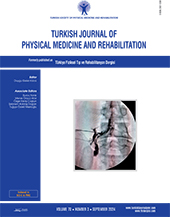Investigation of the effects of different treatment approaches on lumbar stabilizer muscles and diaphragm motility in individuals with chronic low back pain
2 Department of Physical Medicine and Rehabilitation, Nicosia State Hospital, Nicosia, Cyprus
3 Department of Physical Medicine and Rehabilitation, Kyrenia University, Kyrenia, Cyprus DOI : 10.5606/tftrd.2024.13257 Objectives: This study aimed to examine effects of core stabilization and aerobic exercises on lumbar stabilizer muscles and diaphragm motility in individuals with chronic low back pain (CLBP).
Patients and methods: Fifty-one patients (19 males, 32 females; mean age: 32.7±8.8 years; range, 20 to 60 years) with CLBP were included in this randomized controlled trial between March 2021 and May 2022. The patients were divided into three groups: the core group, the aerobic group, and the control group. Conventional treatments (hotpack, transcutaneous electrical nerve stimulation, ultrasound, and McKenzie exercises) were applied to all three patient groups. The core group received core stabilization exercises, and the aerobic group received aerobic exercises. The control group received only conventional treatments. Exercises were continued for six weeks. All patients were assessed through the Beck Depression Inventory (BDI), Visual Analog Scale (VAS), Roland Morris Disability Questionnaire (RMDQ), and Nottingham Health Profile (NHP). Trunk flexor and extensor strength, as well as trunk flexor and back extensor endurance, was examined. Structural features of the multifidus (MF), transversus abdominis (TrA), external oblique (EO), internal oblique (IO), and diaphragm muscles, as well as diaphragm motility, were evaluated with ultrasound imaging. All measurements were repeated before and after six weeks of treatment.
Results: In all groups, post-treatment values of VAS rest/activity, trunk flexor endurance, back extensor endurance, trunk flexor/extensor muscle strength, BDI, RMDQ and, NHP scores improved significantly compared to pre-treatment (p=0.001). Resting and contraction thicknesses of TrA, MF, EO, and IO muscles increased significantly in both the core (p=0.001/0.001, p=0.001/0.002, p=0.001/0.001, and p=0.001/0.001, respectively) and aerobic groups (p=0.001/0.013, p=0.002/0.020, p=0.001/0.004, and p=0.001/0.010, respectively), while the control group did not show any significant difference (p=0.229/0.064, p=0.052/0.102, p=0.069/0.449, and p=0.094/0.146, respectively). After treatment, all groups showed significant increments in end-expiratory thickness (p=0.001), end-inspiratory thickness (p=0.001), motility of diaphragm during normal breathing (control, p=0.003; core, p=0.001; aerobic, p=0.001), and deep breathing (control, p=0.007; core, p=0.001; aerobic, p=0.001).
Conclusion: While aerobic and core stabilization exercises provided significant improvements in individuals with CLBP, the core stabilization group showed the best improvement in all parameters. Accordingly, the necessity of aerobic and core stabilization exercises in treatment programs comes to the fore in individuals with CLBP.
Keywords : Core exercise, diaphragm motility, low back pain, lumbar stabilizer muscles
















